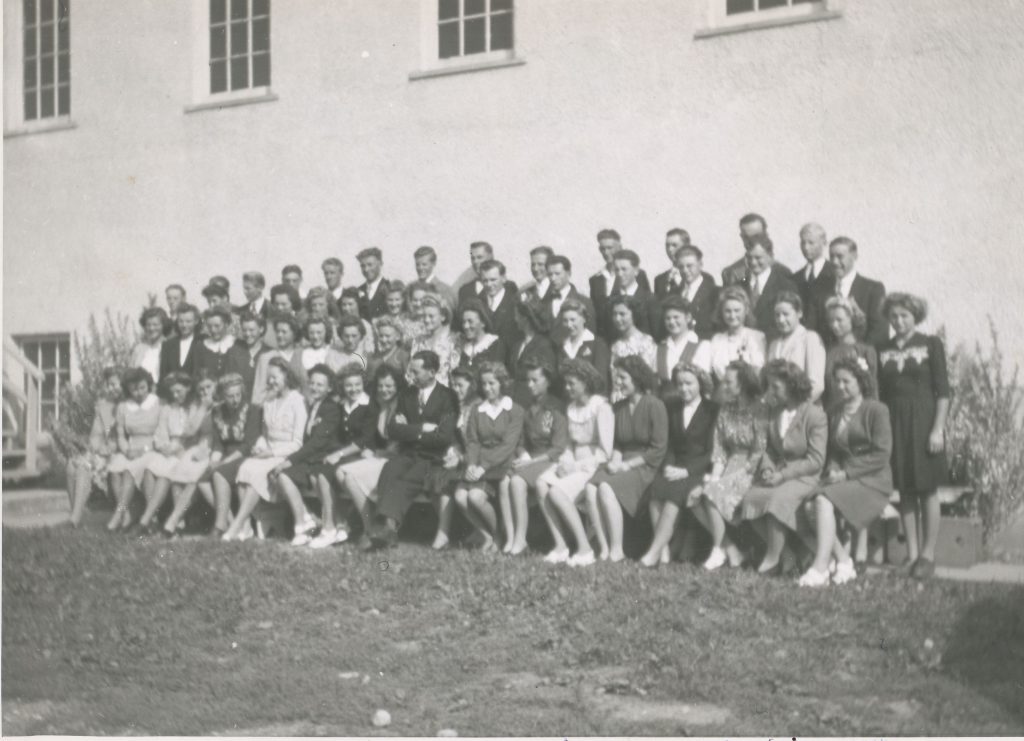How did Mennonites transition from being viewed as a perceived threat and too isolated to assimilate, to being active in the community as respected citizens as we see in the late 20th century? Part of the answer can be seen in both acceptance by the non-Mennonite community, as well as the gradual willingness of Mennonites to assimilate into Canadian society. In the final years of World War II and during the post war years, there is evidence of growing cross-cultural cooperation among Mennonites and their non-Mennonite neighbors.

Yarrow Mennonite Brethren Youth Choir, 1946. Mennonite Historical Society of BC [125-5-6-2006.170.004]
Newspapers feature community events that involve cross-cultural collaboration; the Chilliwack Progress included a Mennonite choir performance drawing a large audience in April 1945. In 1951, an advertisement for a joint Mennonite choir performance, with “well-known musical coach and conductor” Mr. Neufeld conducting, actually presented Mennonites in a positive light. In addition, the Mennonite Central Committee, a relief organization, was commended in the Chilliwack Progress in the April 15, 1953 issue, for its generous giving for “compassionate purposes.” These instances are an early sign that minds and hearts were beginning to open among Fraser Valley residents to Mennonites.
Increased Assimilation
“Perhaps… the answer is in the young people. A liaison of young people, representing a broad cross section of the two communities, might provide the answers. Anything such a group could do to promote understanding and co-operation would be a valuable contribution.”
- Chilliwack Progress, September 25, 1946
We see Mennonites, especially of younger generations, begin to participate in Canadian society in the late 1940s and early 1950s. After World War II, those who had served in the military as well as conscientious objectors who worked at remote camps returned, and their experiences in the “‘English’ secular world” opened up Mennonite communities to new influences. Youth in Yarrow began to branch out beyond Mennonite church events and attend non-Mennonite Youth for Christ programs in Chilliwack. Mennonite businessmen began to establish businesses in Yarrow and across the Fraser Valley, earning respect in the wider business community, and Mennonite women began to adopt the modern Canadian styles of dressing and wearing their hair.
Many Mennonites also increasingly spoke English in order to participate in Canadian culture. In the 1950s, Mennonite churches began to transition from German to English services, appearing more open to English-speaking members as well. Also, an article in the Chilliwack Progress on November 2, 1949, entitled “Displaced Persons Throng M.B. Church” recounts the meeting of one thousand displaced persons from Russia, new immigrants that were working on farms in the Fraser Valley. Reverend Thiessen addressed the audience, and stressed the importance of integrating into society: “‘We want to be an industrious people, a God-fearing people, to be one of the big family of Canadian people…’ He advised all Displaced Persons to learn English as quickly as possible, saying, ‘The knowledge of the language of Canada will open many doors to our people.’” Through these changes we see a growing openness to Canadian norms, with Mennonites building a positive relationship with others in the Fraser Valley.